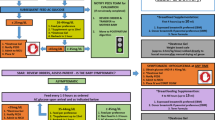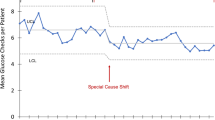Abstract
Objective
Examine neonatal hypoglycemia (NH) outcomes based on type of feeding provided with first dextrose gel.
Study design
Retrospective matched cohort study of 99 infants ≥35 weeks gestational age who received dextrose gel in combination with breastfeeding, formula feeding, or donor milk feeding for NH. The exposure was feeding type. The outcomes were: (1) median change in blood glucose (Δ BG) concentration after first gel, (2) odds of second gel, and (3) odds of recurrent NH.
Results
Median Δ BG was greater in formula (17.0 mg/dL) and donor milk (19.0 mg/dL) fed vs. breastfed infants (7.0 mg/dL). Donor milk and formula feeding were both associated with lower odds of second gel and recurrent NH. Associations remained significant in late-preterm infants, but only formula feeding remained significant in full-term infants.
Conclusions
Formula and donor milk feedings both raised blood sugar concentrations, but the impact differed by gestational age.
This is a preview of subscription content, access via your institution
Access options
Subscribe to this journal
Receive 12 print issues and online access
$259.00 per year
only $21.58 per issue
Buy this article
- Purchase on Springer Link
- Instant access to full article PDF
Prices may be subject to local taxes which are calculated during checkout

Similar content being viewed by others
References
Harris DL, Weston PJ, Harding JE. Incidence of neonatal hypoglycemia in babies identified as at risk. J Pediatr. 2012;161:787–91.
Sharma A, Davis A, Shekhawat PS. Hypoglycemia in the preterm neonate: etiopathogenesis, diagnosis, management and long-term outcomes. Transl Pediatr. 2017;6:335–48.
Thornton PS, Stanley CA, De Leon DD, Harris D, Haymond MW, Hussain K, et al. Recommendations from the pediatric endocrine society for evaluation and management of persistent hypoglycemia in neonates, infants, and children. J Pediatr. 2015;167:238–45.
Rawat M, Chandrasekharan P, Turkovich S, Barclay N, Perry K, Schroeder E, et al. Oral dextrose gel reduces the need for intravenous dextrose therapy in neonatal hypoglycemia. Biomed Hub. 2016;1:1–9.
McKinlay CJD, Alsweiler JM, Ansell JM, Anstice NS, Chase JG, Gamble GD, et al. Neonatal glycemia and neurodevelopmental outcomes at 2 years. N Engl J Med. 2015;373:1507–18.
McKinlay CJD, Alsweiler JM, Anstice NS, Burakevych N, Chakraborty A, Chase JG, et al. Association of neonatal glycemia with neurodevelopmental outcomes at 4.5 years. JAMA Pediatr. 2017;171:972–83.
Kaiser JR, Bai S, Gibson N, Holland G, Lin TM, Swearingen CJ, et al. Association between transient newborn hypoglycemia and fourth-grade achievement test proficiency: a population-based study. JAMA Pediatr. 2015;169:913–21.
Newnam KM, Bunch M. Glucose gel as a treatment strategy for transient neonatal hypoglycemia. Adv Neonatal Care. 2017;17:470–7.
Gregory K, Turner D, Benjamin CN, Monthe-Dreze C, Johnson L, Hurwitz S, et al. Incorporating dextrose gel and feeding in the treatment of neonatal hypoglycaemia. Arch Dis Child Fetal Neonatal Ed. 2020;105:45–9.
Harris DL, Gamble GD, Weston PJ, Harding JE. What happens to blood glucose concentrations after oral treatment for neonatal hypoglycemia? J Pediatr. 2017;190:136–41.
Breastfeeding SO. Breastfeeding and the use of human milk. Pediatrics. 2012;129:e827–41.
Sen S, Benjamin C, Riley J, Heleba A, Drouin K, Gregory K, et al. Donor milk utilization for healthy infants: experience at a single academic center. Breastfeed Med. 2018;13:28–33.
Perrin MT. Donor human milk and fortifier use in United States level 2, 3, and 4 neonatal care hospitals. J Pediatr Gastroenterol Nutr. 2018;66:664–9.
Cooper AR, Barnett D, Gentles E, Cairns L, Simpson JH. Macronutrient content of donor human breast milk. Arch Dis Child Fetal Neonatal Ed. 2013;98:F539–41.
Wojcik KY, Rechtman DJ, Lee ML, Montoya A, Medo ET. Macronutrient analysis of a nationwide sample of donor breast milk. J Am Diet Assoc. 2009;109:137–40.
Committee on Fetus and Newborn AdamkinDH. Postnatal glucose homeostasis in late-preterm and term infants. Pediatrics. 2011;127:575–9.
Dinno A. Nonparametric pairwise multiple comparisons in independent groups using Dunn’s test. Stata J. 2015;15:292–300.
Turner D, Monthé-Drèze C, Cherkerzian S, Gregory K, Sen S. Maternal obesity and cesarean section delivery: additional risk factors for neonatal hypoglycemia? J Perinatol. 2019;39:1057–64.
Harris DL, Weston PJ, Signal M, Chase JG, Harding JE. Dextrose gel for neonatal hypoglycaemia (the Sugar Babies Study): a randomised, double-blind, placebo-controlled trial. Lancet. 2013;382:2077–83.
Weston P, Harris D, Harding J. Dextrose gel and formula but not breast milk are effective treatments for neonatal hypoglycaemia. J Paediatr Child Health. 2017;53(Suppl 2):3–117.
Jenness R. The composition of human milk. Semin Perinatol. 1979;3:225–39.
BarquetDeneb M, Graciela H-PM, Bárbara L-V, Adrián O-V, Dagoberto D-F, La F-C, et al. Early parenteral protein and glucose control in extremely low birth weight infants. Acad J Pediatr Neonatol. 2017;4:51–4.
Bagnoli F, Vodo F, Vodo S, Conte ML, Tomasini B, Vodo Z, et al. Glucagon and insulin cord blood levels in very preterm, late preterm and full-term infants. J Pediatr Endocrinol Metab. 2014;27:419–23.
Acknowledgements
We would like to acknowledge Linda Rosen from the BMC Data warehouse for her work in assistance with data management for this project.
Author information
Authors and Affiliations
Contributions
SS, CA, DT, and EW conceptualized and designed the study. CA did the formal analysis. SS, CA, DT, EA, CMD, and EW helped to write the paper. All authors gave their final approval of the version to be published and agree to be accountable for all aspects of the work.
Corresponding author
Ethics declarations
Conflict of interest
The authors declare that they have no conflict of interest.
Additional information
Publisher’s note Springer Nature remains neutral with regard to jurisdictional claims in published maps and institutional affiliations.
Supplementary information
Rights and permissions
About this article
Cite this article
Sen, S., Andrews, C., Anderson, E. et al. Type of feeding provided with dextrose gel impacts hypoglycemia outcomes: comparing donor milk, formula, and breastfeeding. J Perinatol 40, 1705–1711 (2020). https://doi.org/10.1038/s41372-020-00776-y
Received:
Revised:
Accepted:
Published:
Issue Date:
DOI: https://doi.org/10.1038/s41372-020-00776-y
This article is cited by
-
Implementation and outcomes of a standard dose dextrose gel protocol for management of transient neonatal hypoglycemia
Journal of Perinatology (2022)
-
Supplementation-based hypoglycemia guidelines including donor breast milk reduce NICU admission
Journal of Perinatology (2021)
-
Care of Infants Born to Women with Diabetes
Current Diabetes Reports (2020)



